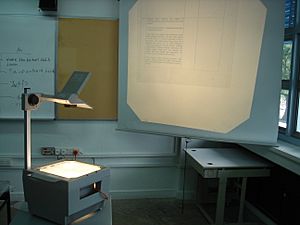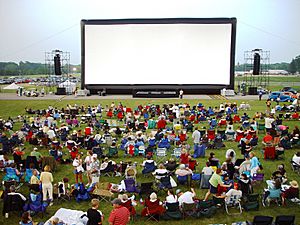Projection screen facts for kids
A projection screen is a special surface used to show a projected image to a group of people. Think of it like a big canvas for a digital projector or movie projector.
Screens can be set up in different ways. Some are fixed in place, like the giant screens in a movie theater. Others might be painted right onto a wall. Many screens are portable, meaning you can move them around. These often come with a tripod stand or can roll up from a base, perfect for a conference room or a classroom. There are even cool inflatable screens for showing movies outdoors, like at a park!
Most projection screens are white or grey. This helps make sure the colors of the image look natural. The best brightness for a screen depends on things like how much light is in the room and how powerful the projector is. Screens can be flat or curved. Flat screens are more common.
You can also have screens for front projection or back projection. Front projection is when the projector is on the same side as the audience, which is the most common setup. Back projection means the projector is behind the screen, shining through it. Front projection screens work by bouncing light off their surface, while back projection screens let light pass through them.
Contents
Types of Projection Screens
Projection screens come in many forms, each designed for different places and uses.
Screens in Movie Theaters
In big movie theaters, the screen is a special reflective surface. It might be shiny (aluminized) for good contrast, or white with tiny glass beads for a super bright picture in dark rooms. These screens also have hundreds of tiny holes. These holes let sound from the speakers and subwoofers, which are often placed right behind the screen, reach the audience.
Fixed Wall Screens
Some screens are mounted directly onto a wall. These are called rigid wall-mounted screens. They keep their shape perfectly, which is great for showing images that need to be very accurate. You often see these in home theaters where people want the best picture quality.

Pull-Down Screens
Pull-down screens, also known as manual wall screens, are popular in places where a permanent screen would take up too much space. They are usually made of fabric that rolls up into a case when you're not using them. This makes them less noticeable when you don't need the screen.
Fixed-Frame Screens
Fixed-frame screens are stretched tightly over a frame. This makes the screen surface very smooth and flat, giving you the best possible image quality. They are often used in home theaters and professional settings where the screen doesn't need to be hidden away.
Electric Screens
Electric screens are similar to pull-down screens, but they use an electric motor to raise and lower the screen. You can control them with a remote or a wall switch. Some projectors can even connect to these screens and automatically lower them when you turn the projector on, and raise them when you turn it off! These screens are often larger and can be mounted on a wall, ceiling, or even hidden inside the ceiling.
Switchable Screens
Switchable projection screens are pretty cool! They can change from being opaque (you can't see through them) to clear (you can see through them). When they are opaque, you can project an image onto them, and people can see it from both sides. This is great for advertising on store windows.
Mobile Screens
Mobile screens are designed to be easily moved. They often have a pull-down screen on a stand, or they pull up from a weighted base. These are perfect when you can't attach a screen to a wall or ceiling, like for outdoor events or temporary setups.
Both mobile and permanent pull-down screens can be "tensioned" or "not tensioned." Tensioned screens try to keep the fabric very flat and still. Non-tensioned screens hang freely, so if there's a breeze in the room, the image might wobble a bit.
Screen Brightness
One important feature of a projection screen is its "gain." This tells you how much light the screen reflects compared to a standard white surface. A higher gain means the screen reflects more light back towards the audience, making the image appear brighter.
However, very high gain screens can sometimes create a "hot spot." This is a bright area on the screen that looks much brighter than the rest. It happens because the screen is reflecting too much light directly back from the projector lens.
Another thing to know is that screens can be grey. A grey screen might look darker, but it can still have a high gain. Grey screens are designed to improve the perceived contrast of the image.
Image Quality and Contrast
The quality of a projected image, especially its contrast (the difference between the brightest and darkest parts), depends on several things. These include how much light is in the room, how powerful your projector is, and how big the image is.
A larger screen means the light from the projector is spread out more, so the image might look less bright and have less contrast if there's a lot of light in the room. You can help improve this by decorating the room with dark colors, which absorb light instead of reflecting it.
Manufacturers of home theater screens try to solve the problem of room light by making surfaces that send more light back to the projector (and thus to the audience, if they are near the projector).
Grey Screens and Contrast
Grey screens are a newer idea to make images look better. They are designed to make dark colors appear darker than they would on a white screen. A grey screen reflects less light overall, both from the projector and from the room. This means the bright parts of the image might be a little dimmer, but the dark parts (like black) will look much closer to true black. That's why many companies call their grey screens "high-contrast" models.
Even though a screen can't actually change how much contrast a projector produces, it can make the contrast seem better to your eyes. Grey screens work best in a dark room where the only light comes from the projector. This is because they are very good at dealing with the light from the projector itself.
Screen Shape
Most projectors are made to show a perfectly rectangular image on a flat screen. Some screens are square, like those used with overhead projectors. These have a 1:1 aspect ratio.
If the audience is close to the projector, a curved screen can sometimes be used without making the image look strange. However, if viewers are too far away or off to the side, the image might look distorted.
See also
 In Spanish: Pantalla de proyección para niños
In Spanish: Pantalla de proyección para niños
- Cathode ray tube
- Contrast ratio
- Holographic screen
- Home cinema
- Inflatable movie screen
- Rear-projection television
- Video projector


